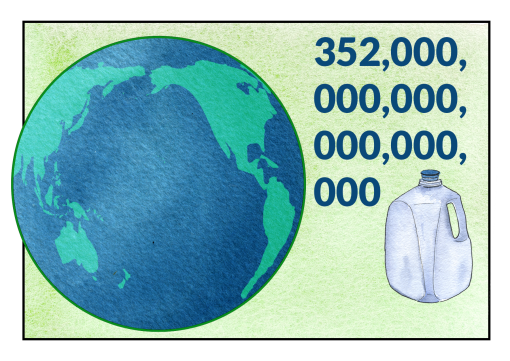How much water is in the ocean? And 20 more must-know sea stats

Q is for Quintillion — a very large number that looks like 100,000,000,000,000,000! As the E/V Nautilus has discovered in recent explorations, there are just as many interesting facts about the deep-sea. Explore below to learn more about our world underwater.
- How much water is in the ocean?
The ocean contains 352 quintillion gallons of water! Water enters the ocean from rivers and melting ice and leaves the ocean into the atmosphere through evaporation.
- How many animals are believed to live in the ocean?
Because so much of our oceans remain unexplored, it is impossible to know just how many species of animals call its waters home. Scientists estimate that 91 percent of ocean species have yet to be classified, which makes Nautilus’ work vital. One study found that there are at least 228,450 known species in the ocean — and an estimated 2.1 million that have yet to be discovered.
- How many shipwrecks are in the ocean?
The seafloor provides an often untouched record of human history, making it an important target of exploration for archeologists studying the complex chronicles of humanity. It is estimated that 3 million shipwrecks can be found across the ocean floor around the planet — most of which have yet to be discovered!
- How deep can ROV Hercules explore?
The Volkswagen beetle-sized ROV is built to withstand pressures at a depth of 4,000 meters (13,100 feet) with more than 6,000 pounds per square inch (psi) of force. That’s about 2.5 miles deep! ROV Little Hercules was designed to withstand pressure and be operable at 6,000 meters (19,700 feet) deep.
- How deep is the ocean?
The average depth of the ocean measures about 12,100 feet (3600 meters) — or about 2.3 miles down! The age and size of an ocean influence its depth. The Pacific is the deepest basin of the global ocean.
- How big is the ocean?
The majority of our planet’s surface is covered in water! The world’s ocean covers 71% of Earth’s surface, which equates to around 139 million square miles (360 million square kilometers) of salty blue.
- What is the deepest point of the ocean?
Located at a depth of more than 35,000 feet (10,600 meters) below the surface of the ocean, the Challenger Deep portion of the Mariana Trench is the deepest point of the ocean.
- How long can a deep-sea coral colony live?
Deep-sea corals continue to surprise scientists with their exceptional ability to thrive in some of the most inhospitable environments on Earth — and they’ve been doing so for thousands of years! A coral colony has the ability to survive for millennia, which allows researchers to piece together environmental puzzles, such as major climatic events throughout the course of our planet’s history.
- Exactly how hot are hydrothermal vents?
Hydrothermal vents are fissures in the Earth's seafloor that spew superheated, mineral-rich water — like geysers fueled by volcanoes! Seawater in hydrothermal vents can reach over 700° Fahrenheit (370° Celsius), yet the seawater doesn’t boil because of the extreme pressure at the depths where these unique features are found.
- What percentage of the seafloor remains to be mapped?
We have better maps of Mars than we do our own ocean! As of June 2020, The Nippon Foundation-GEBCO Seabed 2030 Project, which aims to facilitate the complete mapping of the global ocean floor by 2030, just one-fifth of the world’s entire ocean floor has been mapped. That equates to maps of only an area twice the size of Australia!
- What is the world’s longest mountain range?
Spanning more than 40,000 miles (64,000 kilometers) around the planet, the mid-ocean ridge is the world’s longest mountain range. But there’s a very slim chance of seeing this unique formation with your own eyes — over 90% of the mid-ocean ridge is underwater.
- What is the pressure at the bottom of the ocean?
For every 33 feet (10 meters) of depth, the pressure of the ocean increases by one atmosphere. At the bottom of the Mariana Trench — the deepest part of the ocean — the pressure is more than 16,000 pounds per square inch (PSI). By comparison, the sea level surface air pressure humans exist in daily is 14.7 PSI.
- How many volcanoes are under the ocean?
The majority of our planet’s most active volcanic systems are underwater below 2,000 meters. Altogether, there are an estimated 75,000 volcanoes rising more than a half-mile (1 kilometer) above the ocean floor.
- What is the world’s largest living structure in the ocean?
Located off the coast of Australia, the Great Barrier Reef stretches more than 1,400 miles. Not only is the reef the largest living structure on Earth, but it is also visible from space.
- How much oxygen does the ocean produce?
In short: a lot. Tiny photosynthetic organisms, known as phytoplankton, help to turn sunlight into oxygen, just like plants do on land. Scientists believe that between 50% and 80% of oxygen produced on Earth comes from our oceans. Plankton sinking as marine snow is also an important food source for deep sea organisms.
- How many species of sponges have scientists described?
We know very little about deep-sea sponges, but we’re sure these aquatic invertebrates are quite abundant! To date, scientists have described over 8,500 species of sponges around the world but there are likely more than 25,000, making it very likely that many specimens collected by researchers aboard E/V Nautilus could be new, previously undescribed species.
- Where is the world’s largest waterfall?
Here’s a hint: it’s in the ocean. Physical forces separate water of different temperatures with warm water rising and cold, denser water sinking. Cold dense water travels along the seafloor. In the Denmark Strait, between Iceland and Greenland, cold dense water flows over the Denmark Cataract rapidly falling 2400 meters creating the world’s largest waterfall.
- How deep can light penetrate the ocean?
When exploring the deep waters of our oceans, ROV Hercules brings its own lighting system. That’s because sunlight entering the water can only travel up to 1,000 meters under the best of conditions, but in most cases is unable to penetrate beyond 200 meters.
- What is the most remote location in the world?
That title goes to Point Nemo, a place on the map located between South America and New Zealand. Made famous in Jules Verne’s Twenty Thousand Leagues Under the Sea, Point Nemo is located more than 1,600 miles (2,600 kilometers) from the nearest land at coordinates 48°52.6′S, 123°23.6′W.
- How much of the ocean has E/V Nautilus mapped?
In addition to informing dive objectives, Nautilus’ mapping operations transit over unmapped areas to contribute to the Seabed 2030 initiative, an international collaborative project to combine all bathymetric data in order to create a comprehensive map of the ocean floor. Since 2012, we have mapped over 96,500 square miles (250,000 square kilometers) of the seafloor in the Atlantic, Gulf of Mexico, Caribbean Sea, and the Pacific Ocean which is 0.07% of the ocean. Thankfully many organizations are working toward the goal of a global ocean map.
- How far can E/V Nautilus travel?
Measuring in at 223 feet (68 meters), our exploration vessel can travel 13,000 nautical miles (24,000 kilometers) at 10 knots on a fill-up and spend up to 40 consecutive days at sea.



